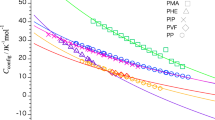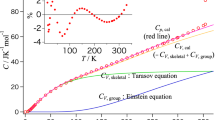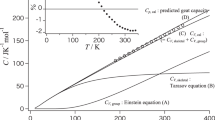Abstract
ATTEMPTS to relate polymer properties to structure have usually involved the assumption of a two-phase structural model: crystalline regions embedded in an amorphous matrix. The crystalline and amorphous regions in the structure are each presumed to have well-defined properties which do not vary as the proportions change in different polymers. With this model, the variables available to compare different samples of the same polymer are: crystallite size, shape and orientation correlation; orientation effects in the amorphous material; and the relative amounts of crystalline and amorphous material present. The last parameter mentioned is termed ‘degree of crystallinity’, and it is measured in various ways: by techniques involving X-ray diffraction, density, infra-red, nuclear magnetic resonances, chemical reactivity, and swelling measurements. The degree to which the results of these techniques correlate is a measure of the validity of the two-phase model. Farrow and Ward1 found little correlation between crystallinity measurements on polyethylene terephthalate fibres by X-ray diffraction, density and infra-red techniques. Similar comparisons between crystallinity measurements on polypropylene by various techniques were reported by Quynn, Riley, Young and Noether2 with similar inconsistencies. Nuclear magnetic resonance studies of polyethylene and polypropylene fibres by Hyndman and Origlio3 indicated the existence of a distinct phase intermediate in degree of order between the crystalline and amorphous phases. Sobue and Tabata4 found X-ray evidence for polymorphism in polypropylene.
This is a preview of subscription content, access via your institution
Access options
Subscribe to this journal
Receive 51 print issues and online access
$199.00 per year
only $3.90 per issue
Buy this article
- Purchase on Springer Link
- Instant access to full article PDF
Prices may be subject to local taxes which are calculated during checkout
Similar content being viewed by others
References
Farrow, G., and Ward, J. M., Polymer, 1, 330 (1960).
Quynn, R. G., Riley, J. L., Young, D. A., and Noether, H. D., J. App. Polymer Sci., 2, 166 (1959).
Hyndman, D., and Origlio, G. F., J. Polymer Sci., 39, 556 (1959).
Sobue, H., and Tabata, Y., J. Polymer Sci., 39, 427 (1959).
Tiensuu, V. H., Ergun, S., and Alexander, L. E., J. App. Phys., 35, 1718 (1964).
Author information
Authors and Affiliations
Rights and permissions
About this article
Cite this article
SEGERMAN, E., STERN, P. Two-phase Model for Structure of Polymers. Nature 210, 1258–1259 (1966). https://doi.org/10.1038/2101258a0
Issue Date:
DOI: https://doi.org/10.1038/2101258a0
This article is cited by
-
Structural, Optical and Electrical Studies on Hybrid Material of In Situ Formed Silver sulfide in Polymer Blend Matrix
Journal of Inorganic and Organometallic Polymers and Materials (2019)
-
On the dynamic mechanical behavior of nylon 66
Kolloid-Zeitschrift & Zeitschrift für Polymere (1970)
-
Some dielectric properties of dry keratin
Kolloid-Zeitschrift und Zeitschrift für Polymere (1968)
Comments
By submitting a comment you agree to abide by our Terms and Community Guidelines. If you find something abusive or that does not comply with our terms or guidelines please flag it as inappropriate.



